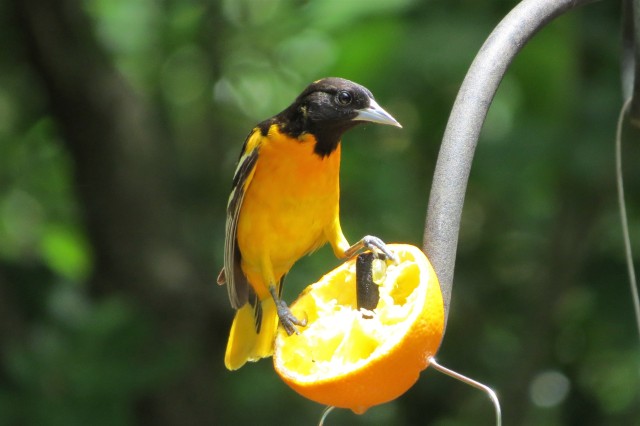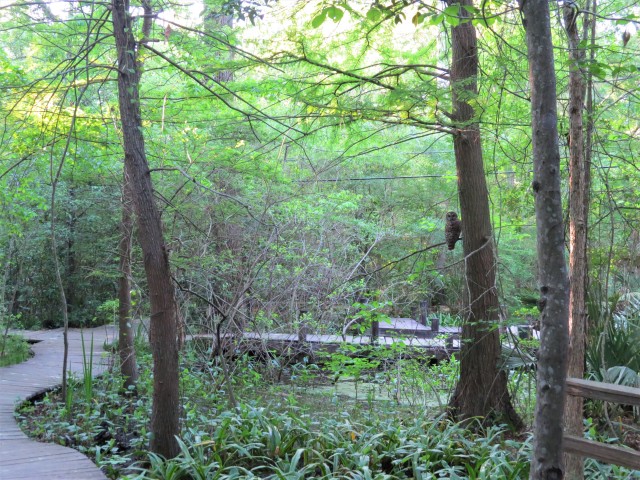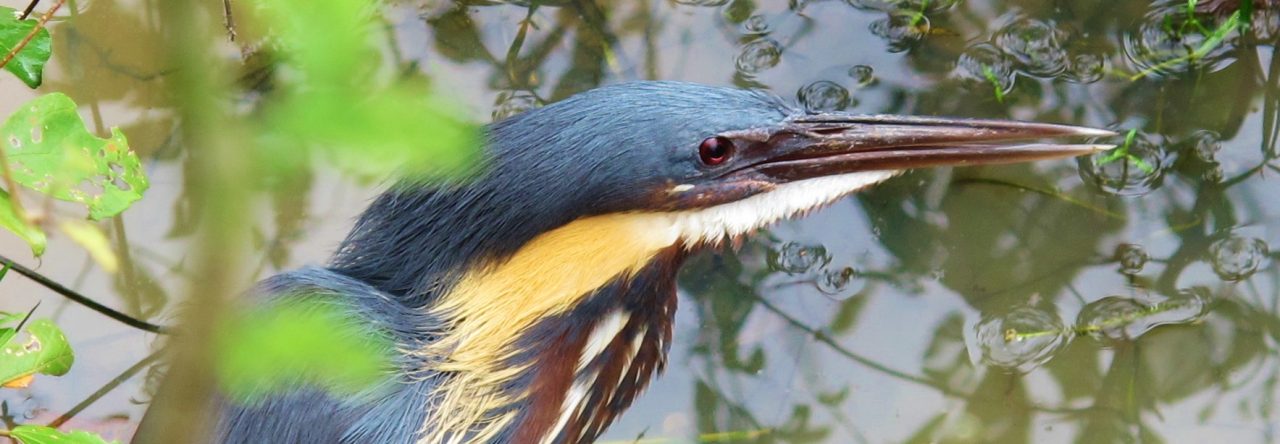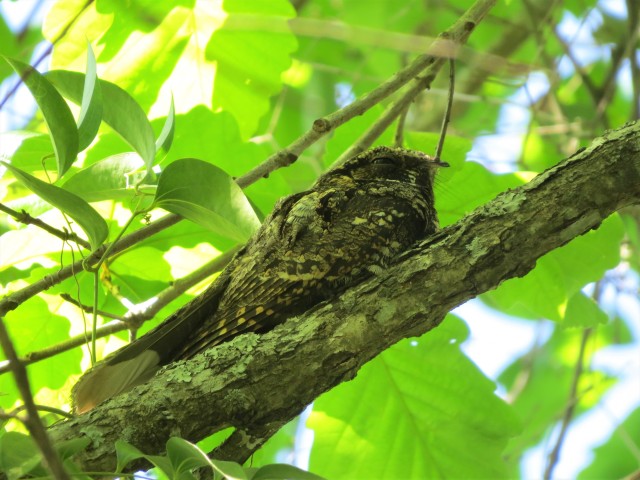
In writing this article on May 24th – about a week before the “official” end of Spring – I am leaving myself wide open to having to revise it when a Connecticut or MacGillivray’s Warbler turns up in the last few days of the month! I can only hope!
For background information about the reserve, please refer to my post from last year: Spring at Edith L Moore Nature Sanctuary.
Spring 2019 was an excellent one at Edith L Moore. Although I “only” visited the site 58 times between March and May (compared to 76 visits during the same period in 2018), I recorded 101 bird species – 5 more than in 2018.
While April 2019 could best be described as “average” what really set this year apart was a superb run of days in early May. The month kicked off with a Black-billed Cuckoo on May 1st and never looked back, with multiple days in early May when individual observers saw nearly 50 species at the site and the daily species total was often 60+.
In fact, the number and variety of warblers at ELM in early May regularly trumped the famous coastal hotspots, thanks to favorable winds which allowed migrants to overshoot the coastal woodlots and drop in to more favorable habitats further inland such as ELM. Saturday 4th May was perhaps the peak day of the spring, with 26 warbler species noted at Edith L Moore between all observers – the kind of number that would be impressive even at High Island or Sabine Woods!
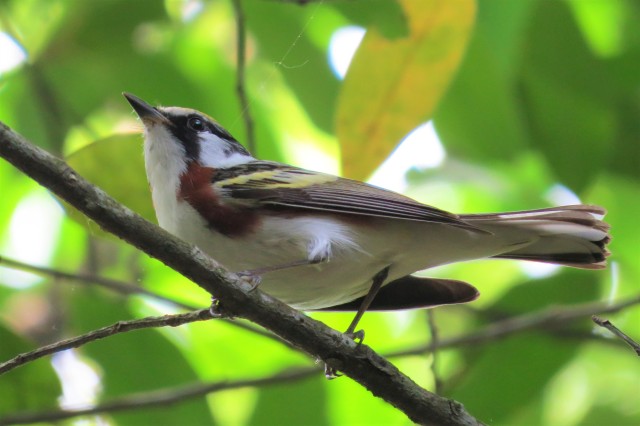
I saw a total of 29 warbler species here between March and May, which I have classified in rough order of abundance below, based on the number of eBird checklists on which I recorded each species. “Bird-days” adds up the total number of birds and the total number of occasions seen.
Please note that these are only my personal sightings; many other observers regularly monitored avian comings and goings on the reserve during the spring, and their lists include several birds that I did not see at all; their impressions of the abundance of certain species will also no doubt differ from mine!
| # | Species | # of checklists | High count | Bird days | First seen | Last seen | Notes |
| 1 | Ovenbird | 25 | 10 | 65 | April 18th | May 20th | Common migrant |
| 2 | Hooded Warbler | 21 | 8 | 40 | March 18th | April 26th | Common early season migrant |
| 3 | Chestnut-sided Warbler | 17 | 5 | 35 | April 25th | May 20th | Common late season migrant |
| 4 | Black-and-white Warbler | 15 | 3 | 23 | March 18th | May 10th | Long migration season; waves early and late |
| 5 | Magnolia Warbler | 13 | 7 | 37 | April 25th | May 22nd | Common late season migrant |
| 6 | Pine Warbler | 12 | 2 | 18 | Resident in area, occasionally wanders onto reserve | ||
| 7 | Wilson’s Warbler | 12 | 2 | 15 | March 16th | May 4th | No birds overwintered in the park this year. Spring passage from March through early May |
| 8 | American Redstart | 11 | 5 | 28 | April 25th | May 22nd | Common late season migrant |
| 9 | Orange-crowned Warbler | 11 | 3 | 17 | April 10th | Overwinters, with most departing before the end of March | |
| 10 | Northern Parula | 10 | 3 | 15 | March 27th | May 8th | Seen sporadically throughout the spring |
| 11 | Worm-eating Warbler | 10 | 2 | 12 | April 8th | April 30th | Frequently recorded but never numerous |
| 12 | Tennessee Warbler | 8 | 4 | 17 | April 23rd | May 10th | A good year for them |
| 13 | Kentucky Warbler | 8 | 3 | 13 | April 23rd | May 4th | First bird was later than usual, but common during its peak passage period |
| 14 | Black-throated Green Warbler | 8 | 3 | 10 | March 18th | May 10th | Long migration season but never common here |
| 15 | Yellow-rumped Warbler | 7 | 2 | 10 | March 27th | Overwinters, and departs early in spring | |
| 16 | Blackburnian Warbler | 7 | 2 | 8 | April 25th | May 18th | A good spring for these |
| 17 | Golden-winged Warbler | 6 | 2 | 7 | April 26th | May 4th | Fairly common for a limited time; a specialty of the site |
| 18 | Blue-winged Warbler | 5 | 1 | 5 | April 10th | April 26th | Fewer than in 2018, in contrast to most other warblers |
| 19 | Northern Waterthrush | 4 | 2 | 5 | April 25th | May 8th | Infrequently recorded |
| 20 | Common Yellowthroat | 4 | 2 | 5 | April 20th | May 8th | Occasional migrant |
| 21 | Canada Warbler | 4 | 2 | 5 | April 26th | May 9th | A much better showing than last year |
| 22 | Nashville Warbler | 4 | 1 | 4 | April 26th | May 4th | Scarce migrant |
| 23 | Bay-breasted Warbler | 3 | 1 | 3 | May 4th | May 8th | An excellent spring for this scarce species |
| 24 | Swainson’s Warbler | 2 | 1 | 2 | April 11th | April 18th | What was probably the same bird remained for over a week in April, singing in the Church Gate Marsh area. Another was present in early May |
| 25 | Louisiana Waterthrush | 1 | 1 | 1 | March 26th | March 26th | Always scarce here, I saw just one this spring |
| 26 | Prothonotary Warbler | 1 | 1 | 1 | April 4th | April 4th | I only saw one, but it was a good spring for this species with fairly regular reports |
| 27 | Mourning Warbler | 1 | 1 | 1 | May 4th | May 4th | Two confirmed, multi-observer birds this spring, and a third reported – the first records since before Hurricane Harvey devastated its preferred creekside habitat in 2017 |
| 28 | Cerulean Warbler | 1 | 1 | 1 | April 13th | April 13th | A bumper spring for this species at ELM with birds seen occasionally from mid April through early May, although I saw just one of them |
| 29 | Yellow-throated Warbler | 1 | 1 | 1 | May 3rd | May 3rd | Late individual. This species is always rare here. |

Non-warbler highlights of the spring include the above-mentioned Black-billed Cuckoo; a very obliging Eastern Whip-poor-will for one day in March; several Philadelphia Vireos; above-average numbers of Rose-breasted Grosbeaks; and first records for ELM of Bank Swallow and Dark-eyed Junco.
It was an odd spring for thrushes, with lots of Swainson’s and a fair number of Wood Thrushes seen, but no personal records at all of Gray-cheeked Thrush or Veery (although the latter species were both seen by other observers).
| Species | # of checklists (out of 58) | High count | Status |
| Northern Cardinal | 58 | 22 | Common resident |
| Blue Jay | 58 | 14 | Common resident |
| Downy Woodpecker | 58 | 8 | Common resident |
| Carolina Wren | 57 | 13 | Common resident |
| White-winged Dove | 56 | 6 | Common resident |
| American Robin | 51 | 9 | Common resident |
| Red-bellied Woodpecker | 49 | 4 | Common resident |
| Common Grackle | 48 | 50 | Frequent flocks in spring |
| Carolina Chickadee | 47 | 5 | Common resident |
| Ruby-crowned Kinglet | 30 | 8 | Common winter visitor |
| Tufted Titmouse | 30 | 4 | Common resident |
| Cedar Waxwing | 26 | 30 | Common winter visitor |
| Great Crested Flycatcher | 26 | 2 | Migrant and summer visitor |
| Swainson’s Thrush | 25 | 10 | Common migrant |
| Eastern Wood-Pewee | 17 | 6 | Common migrant |
| Pileated Woodpecker | 17 | 2 | Fairly common resident |
| Chimney Swift | 16 | 5 | Fairly common summer visitor |
| Gray Catbird | 16 | 5 | Common migrant |
| White-eyed Vireo | 16 | 3 | Common migrant |
| Blue-gray Gnatcatcher | 14 | 6 | Common winter visitor |
| Wood Thrush | 14 | 5 | Fairly common migrant, probable breeder in 2018 but no sign of breeding this year |
| Barn Swallow | 12 | 5 | Fairly common migrant |
| White-throated Sparrow | 12 | 3 | Fairly common winter visitor |
| Baltimore Oriole | 11 | 15 | Fairly common migrant |
| Rose-breasted Grosbeak | 10 | 12 | Fairly common migrant; a good year for them |
| Red-winged Blackbird | 10 | 5 | Fairly common winter visitor |
| Summer Tanager | 9 | 3 | Fairly common migrant |
| House Finch | 9 | 2 | Occasional feeder visitor |
| Red-eyed Vireo | 8 | 5 | Fairly common migrant for a limited period |
| Indigo Bunting | 8 | 3 | Much less common than in 2018 |
| American Goldfinch | 7 | 4 | Common winter visitor, most departing by end March |
| Mourning Dove | 7 | 2 | Occasional visitor |
| Broad-winged Hawk | 6 | 9 | Occasional migrant |
| Acadian Flycatcher | 6 | 2 | The most frequent empidonax |
| Blue-headed Vireo | 6 | 2 | Fairly common winter visitor |
| Purple Martin | 5 | 2 | Occasional migrant |
| Ruby-throated Hummingbird | 5 | 1 | Occasional migrant |
| Red-tailed Hawk | 5 | 1 | Winters locally and sometimes passes over reserve |
| House Wren | 5 | 1 | One bird overwintered along creek and was seen occasionally |
| Northern Mockingbird | 5 | 1 | Sometimes wanders into the reserve from surrounding suburbs |
| Black Vulture | 4 | 8 | Occasional overhead |
| Chuck-will’s-widow | 4 | 4 | Regular migrant in early April |
| Mississippi Kite | 4 | 3 | Occasional overhead, breeds nearby |
| House Sparrow | 4 | 2 | Occasional feeder visitor |
| Yellow-breasted Chat | 4 | 1 | Occasional migrant |
| Cooper’s Hawk | 3 | 3 | Occasional, unwelcome visitor |
| Great Blue Heron | 3 | 2 | Occasional visitor |
| Great Egret | 3 | 1 | Occasional visitor |
| Turkey Vulture | 3 | 1 | Occasional overhead |
| Tree Swallow | 3 | 1 | Occasional overhead |
| Hermit Thrush | 3 | 1 | Fairly common winter visitor that departs in March |
| Cliff Swallow | 2 | 4 | Irregular overhead |
| Wood Duck | 2 | 2 | Pair on creek on two occasions but no sign of attempting to breed |
| Northern Rough-winged Swallow | 2 | 2 | Irregular overhead |
| Sharp-shinned Hawk | 2 | 1 | Irregular visitor |
| Barred Owl | 2 | 1 | Resident on reserve but not often seen |
| Yellow-bellied Flycatcher | 2 | 1 | Irregular migrant |
| Willow Flycatcher | 2 | 1 | Irregular migrant |
| Least Flycatcher | 2 | 1 | Irregular migrant |
| Philadelphia Vireo | 2 | 1 | Rare migrant; a good year for them |
| Warbling Vireo | 2 | 1 | Irregular migrant |
| Scarlet Tanager | 1 | 2 | Occasional migrant but scarce in 2019 |
| Black-billed Cuckoo | 1 | 1 | First for the reserve since 2013, found by Dennis |
| Eastern Whip-poor-will | 1 | 1 | A one-day bird in March was enjoyed by many observers |
| Little Blue Heron | 1 | 1 | Irregular overhead |
| Cattle Egret | 1 | 1 | Irregular overhead |
| Yellow-throated Vireo | 1 | 1 | Recorded occasionally throughout the spring, but I saw only one |
| Bank Swallow | 1 | 1 | First for the reserve, overhead |
| Dark-eyed Junco | 1 | 1 | First for the reserve, one in March at the south-east marsh |
| Great-tailed Grackle | 1 | 1 | Rare on or over the reserve, but often erroneously reported; almost all grackles seen at ELM are Commons. |
| Painted Bunting | 1 | 1 | Irregular migrant |
| Dickcissel | 1 | 1 | Irregular overhead |
